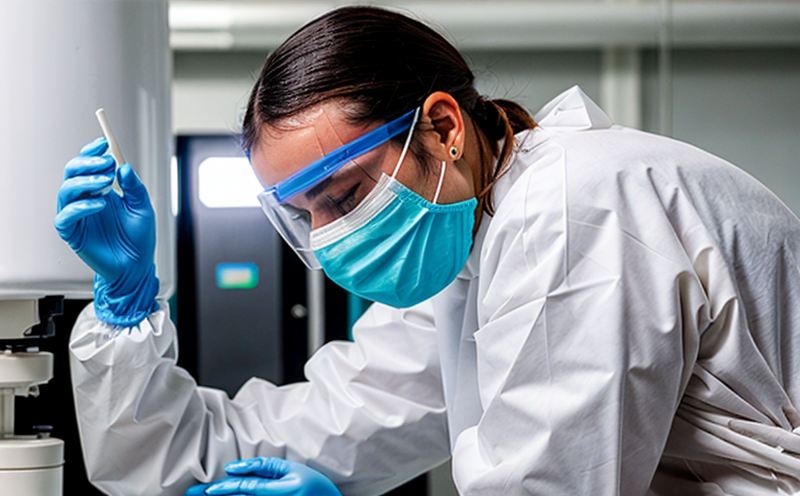ANSI IES RP 27.3 Photobiological Safety Testing of Infrared Radiation Sources
The ANSI IES RP 27.3 standard is a crucial document that addresses the photobiological safety testing for infrared radiation sources used in various lighting applications. This standard ensures compliance with international health and safety regulations, protecting consumers from potential eye and skin damage caused by exposure to high-intensity infrared radiation.
Lighting manufacturers often face challenges in ensuring their products meet these stringent requirements. Eurolab offers comprehensive testing services that adhere strictly to the ANSI IES RP 27.3 standard. Our expertise spans a wide range of applications, including but not limited to LED lighting, OLED displays, and other advanced illumination technologies where infrared radiation is present.
The testing process involves several critical steps designed to evaluate the photobiological safety of infrared radiation sources. Specimens are subjected to rigorous procedures aimed at determining whether they pose any risks under normal usage conditions. Key parameters include wavelength ranges relevant to human exposure limits, maximum permissible exposure (MPE) levels, and temporal integration factors.
Our laboratory uses state-of-the-art equipment calibrated according to the latest international standards such as ISO 17260-3:2019 and IEC TS 62788. This ensures accurate and reliable results that are consistent with global benchmarks. By leveraging this advanced technology, we provide clients with detailed reports outlining compliance levels against ANSI IES RP 27.3 requirements.
In addition to technical excellence, Eurolab prides itself on delivering prompt service tailored to meet individual client needs. Our team of experienced professionals understands the importance of timely delivery and works closely with customers throughout each stage of the testing process—from initial consultation through final report issuance. This approach helps ensure smooth integration into broader quality management systems.
Compliance with ANSI IES RP 27.3 is essential for manufacturers looking to expand their product offerings internationally while maintaining high standards of safety and reliability. By partnering with Eurolab, companies can gain confidence that they are meeting all necessary regulatory requirements without compromising on innovation or performance.
Scope and Methodology
The scope of ANSI IES RP 27.3 covers the evaluation of photobiological hazards associated with infrared radiation generated by lighting products. The standard specifies procedures for measuring and assessing risks based on specific emission characteristics, including peak wavelength, energy distribution over time, and spatial intensity variations.
Testing typically begins with a detailed review of product specifications provided by the manufacturer. This information helps identify key features that may influence photobiological safety performance. Next, specimens are prepared according to standard procedures outlined in ANSI IES RP 27.3. Preparation includes ensuring proper orientation and positioning relative to measurement equipment.
Measurement devices used during testing must be calibrated regularly using reference standards defined by international organizations like ISO or IEC. Data collected from these measurements is then analyzed statistically to determine whether the product complies with specified limits for photobiological safety.
A critical aspect of the methodology involves calculating temporal integration factors (TIFs), which account for variations in human visual sensitivity over different exposure durations. These calculations are essential because they allow accurate determination of potential risks even when actual exposure times vary from expected values.
Once all data have been gathered and analyzed, a final report is prepared summarizing findings regarding compliance with ANSI IES RP 27.3 requirements. This document includes recommendations for any necessary modifications to ensure full adherence to the standard.
Eurolab Advantages
At Eurolab, we pride ourselves on offering unparalleled expertise in photobiological safety testing of infrared radiation sources. Our comprehensive suite of services ensures that our clients receive accurate, reliable results delivered promptly and efficiently. Here are some key advantages:
- Comprehensive Knowledge Base: Our team consists of highly qualified professionals with extensive experience working within the lighting industry.
- State-of-the-Art Equipment: We utilize cutting-edge technology calibrated according to the latest international standards, ensuring precise and repeatable measurements.
- Prompt Delivery: Understanding the importance of timely turnaround times, Eurolab works closely with customers at every stage of the testing process.
- Client-Centric Approach: We tailor our services specifically to meet each client's unique requirements, providing personalized solutions that enhance overall satisfaction and confidence in results.
- Global Recognition: Our commitment to quality has earned us international acclaim, making Eurolab a trusted partner for many leading lighting manufacturers worldwide.
By partnering with Eurolab, companies can rest assured knowing they are receiving the highest level of service available in photobiological safety testing. With our unwavering dedication to excellence and innovation, we strive to exceed expectations every time.
International Acceptance and Recognition
The ANSI IES RP 27.3 standard enjoys widespread acceptance across numerous countries due to its rigorous approach to ensuring photobiological safety for infrared radiation sources. Many nations have adopted this standard as part of their national regulations governing lighting products.
For instance, the European Union's harmonized standards often incorporate provisions derived directly from ANSI IES RP 27.3 when addressing similar issues related to human health and safety concerning artificial light sources. Similarly, countries like Australia and New Zealand have integrated aspects of this standard into their own frameworks for assessing compliance.
Companies operating globally benefit significantly by ensuring their products meet these internationally recognized criteria. Not only does it facilitate easier market entry but also enhances brand reputation among consumers who value product safety above all else.
Eurolab plays an integral role in supporting businesses achieve this goal through our robust testing capabilities and commitment to delivering accurate, reliable results aligned with global expectations. By choosing Eurolab as your partner for ANSI IES RP 27.3 compliance, you are investing in a future where innovation meets rigorous safety standards.





